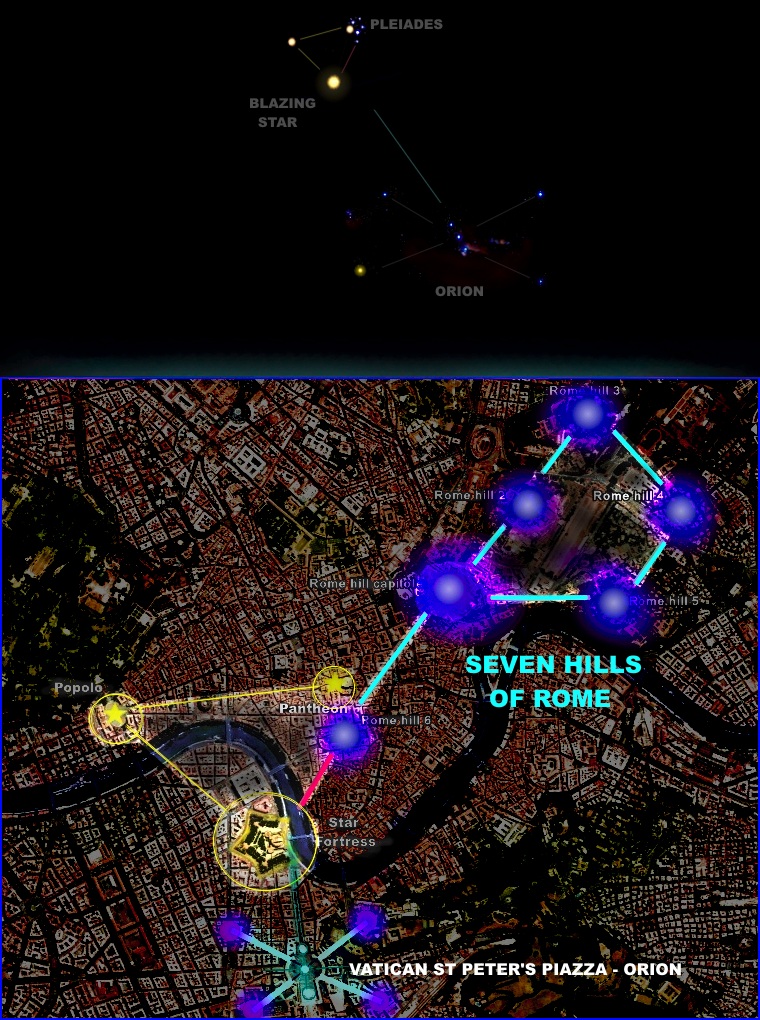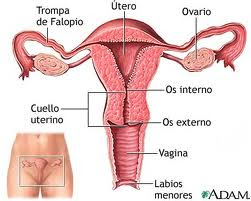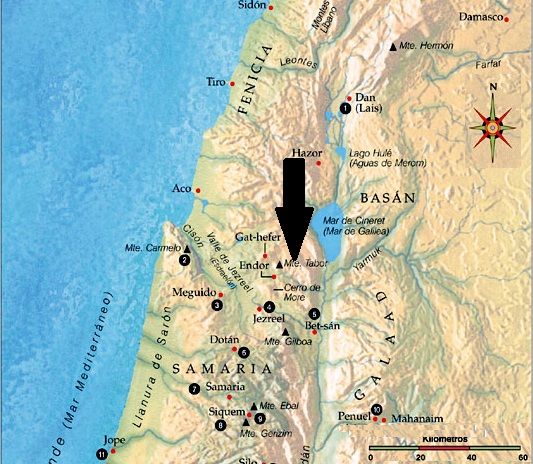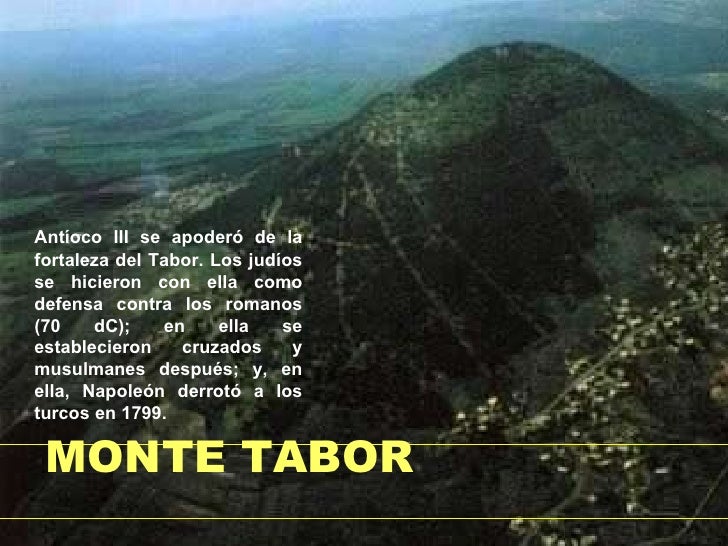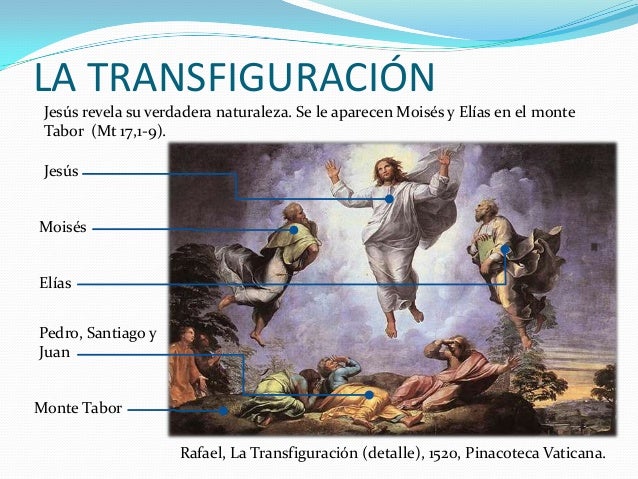|
|
SE DA EL MISMO PATRON DEL LIBRO DE MARCOS 9, LUCAS 9 Y MATEO 16 Y 18 EN EL MARCO A CESAREA DE FILIPO, AL PIE DEL MONTE HERMON (MERIDIANO 33 DE PARIS Y PARALELO 33), EN EL CONTEXTO A LA TRANSFIGURACION DEL NEXO CON JUAN MARCOS (UN NIÑO), EN EL MISMO CONTEXTO EN HECHOS 12- SON TRES (CRISTO, ELIAS Y MOISES) Y TAMBIEN TRES (PEDRO, JUAN Y SANTIAGO) - TREINTA Y TRES - NECHO HECHOS 12:12 (33)
Mateo 16
11. ¿Cómo es que no entendéis que no fue por el pan que os dije que os guardaseis de la levadura de los fariseos y de los saduceos?
12. Entonces entendieron que no les había dicho que se guardasen de la levadura del pan, sino de la doctrina de los fariseos y de los saduceos.
13. Viniendo Jesús a la región de Cesarea de Filipo, preguntó a sus discípulos, diciendo: ¿Quién dicen los hombres que es el Hijo del Hombre?
14. Ellos dijeron: Unos, Juan el Bautista; otros, Elías; y otros, Jeremías, o alguno de los profetas.
15. El les dijo: Y vosotros, ¿quién decís que soy yo?
16. Respondiendo Simón Pedro, dijo: Tú eres el Cristo, el Hijo del Dios viviente.
17. Entonces le respondió Jesús: Bienaventurado eres, Simón, hijo de Jonás, porque no te lo reveló carne ni sangre, sino mi Padre que está en los cielos.
18. Y yo también te digo, que tú eres Pedro, y sobre esta roca edificaré mi iglesia; y las puertas del Hades no prevalecerán contra ella.
16:19 Y a ti te daré las llaves del reino de los cielos; y todo lo que atares en la tierra será atado en los cielos; y todo lo que desatares en la tierra será desatado en los cielos.
Job 38:31: ¿Podrás tú atar los lazos de las Pléyades,
O desatarás las ligaduras de Orión?
Mateo 17
1. Seis días después, Jesús tomó a
, y los llevó aparte a un monte alto; (ESTA RELACIONADO CON JUAN MARCOS, EN EL CONTEXTO A HECHOS 12. LA TRANSFIGURACION TIENE FUERTE RELACION CON ORION.)
2. y se transfiguró delante de ellos, y resplandeció su rostro como el sol, y sus vestidos se hicieron blancos como la luz.
3. Y he aquí les aparecieron Moisés y Elías, hablando con él. (TREINTA Y TRES-PEDRO, SANTIAGO Y JUAN Y CRISTO, MOISES Y ELIAS, OSEA UNA REFERENCIA EXPLICITA AL NUMERO 33)
4. Entonces Pedro dijo a Jesús: Señor, bueno es para nosotros que estemos aquí; si quieres, hagamos aquí tres enramadas: una para ti, otra para Moisés, y otra para Elías.
5. Mientras él aún hablaba, una nube de luz los cubrió; y he aquí una voz desde la nube, que decía: Este es mi Hijo amado, en quien tengo complacencia; a él oíd.
6. Al oír esto los discípulos, se postraron sobre sus rostros, y tuvieron gran temor.
3. Deuteronomio 4:48: Desde Aroer, que está junto a la ribera del arroyo de Arnón, hasta el monte de Sion, que es Hermón;
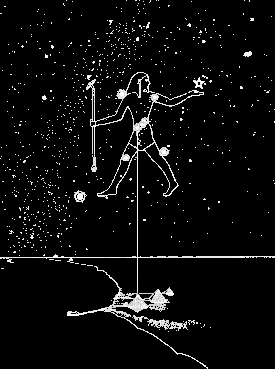
|
Mateo 18
1. En aquel tiempo los discípulos vinieron a Jesús, diciendo: ¿Quién es el mayor en el reino de los cielos?
2. Y llamando Jesús a un niño, lo puso en medio de ellos,
3. y dijo: De cierto os digo, que si no os volvéis y os hacéis como niños, no entraréis en el reino de los cielos.
4. Así que, cualquiera que se humille como este niño, ése es el mayor en el reino de los cielos.
5. Y cualquiera que reciba en mi nombre a un niño como este, a mí me recibe. (NOTEN QUE CRISTO ESTA AFIRMANDO QUE QUIEN RECIBE A ESE NIÑO LO RECIBE A EL MISMO. ES OBVIO EL NEXO CON EL SANTO GRIAL DE ESTA AFIRMACION. EL NIÑO ES CRISTO MISMO)
6. Y cualquiera que haga tropezar a alguno de estos pequeños que creen en mí, mejor le fuera que se le colgase al cuello una piedra de molino de asno, y que se le hundiese en lo profundo del mar.
7. ¡Ay del mundo por los tropiezos! porque es necesario que vengan tropiezos, pero ¡ay de aquel hombre por quien viene el tropiezo!
8. Por tanto, si tu mano o tu pie te es ocasión de caer, córtalo y échalo de ti; mejor te es entrar en la vida cojo o manco, que teniendo dos manos o dos pies ser echado en el fuego eterno.
9. Y si tu ojo te es ocasión de caer, sácalo y échalo de ti; mejor te es entrar con un solo ojo en la vida, que teniendo dos ojos ser echado en el infierno de fuego.
10. Mirad que no menospreciéis a uno de estos pequeños; porque os digo que sus ángeles en los cielos ven siempre el rostro de mi Padre que está en los cielos.
Hechos 12
1. En aquel mismo tiempo el rey Herodes echó mano a algunos de la iglesia para maltratarles.
2. Y mató a espada a Jacobo, hermano de Juan. (AQUI TENEMOS EL NEXO 911, EN EL MARCO A JUAN MARCOS, EN ESTE CAPITULO, EL EN MISMO VERSICULO 12. SON LOS HIJOS DE MARIA DE SALOME, OSEA EL CAMINO DE SANTIAGO. ESTO NOS CONFIRMA EL NEXO 911 CON JUAN MARCOS. AQUI ESTA LA CLAVE 911 EN EL CONTEXTO AL CALENDARIO COPTO. ES OBVIO, EL NEXO CON LA TRANSFIGURACION DE CRISTO, EN EL CONTEXTO A SANTIAGO O JACOBO, JUAN Y PEDRO (FUERON LOS MISMOS QUE ESTUVIERON EN LA TRANSFIGURACION DEL SEÑOR).)
3. Y viendo que esto había agradado a los judíos, procedió a prender también a Pedro. Eran entonces los días de los panes sin levadura. (UN NEXO CON MATEO 16:11 Y 12, EN EL MISMO CONTEXTO A CESAREA DE FILIPO)
12. Y habiendo considerado esto, llegó a casa de María la madre de Juan, el que tenía por sobrenombre Marcos, donde muchos estaban reunidos orando. (ORACION ES UNA CLAVE ORION. LA VIUDA TIENE UN FUERTE NEXO CON DICHA CONSTELACION. HECHOS 12:12 (TREINTA Y TRES))
13. Cuando llamó Pedro a la puerta del patio, salió a escuchar una muchacha llamada Rode,
14. la cual, cuando reconoció la voz de Pedro, de gozo no abrió la puerta, sino que corriendo adentro, dio la nueva de que Pedro estaba a la puerta.
15. Y ellos le dijeron: Estás loca. Pero ella aseguraba que así era. Entonces ellos decían: ¡Es su ángel!
16. Mas Pedro persistía en llamar; y cuando abrieron y le vieron, se quedaron atónitos.
17. Pero él, haciéndoles con la mano señal de que callasen, les contó cómo el Señor le había sacado de la cárcel. Y dijo: Haced saber esto a Jacobo y a los hermanos. Y salió, y se fue a otro lugar.
18. Luego que fue de día, hubo no poco alboroto entre los soldados sobre qué había sido de Pedro.
19. Mas Herodes, habiéndole buscado sin hallarle, después de interrogar a los guardas, ordenó llevarlos a la muerte. Después descendió de Judea a Cesarea y se quedó allí. (AQUI ESTA LA CLAVE DEL CAPITULO 12 DE HECHOS, EN EL CONTEXTO A LA SEÑAL DE JONAS. ES UN NEXO CON LA TRANFIGURACION DE CRISTO EN EL MONTE HERMON, ADONDE CESAREA DE FILIPO ESTA AL PIE DEL MISMO. NADA ES CASUALIDAD AMIGO Y AMIGA. TODO ESTA CODIFICADO. JUAN MARCOS ES EL SANTO GRIAL. GLORIA A DIOS TODOPODEROSO QUE NO DISCRIMINO A LA MUJER Y TAMPOCO A LOS NIÑOS.)
20. Y Herodes estaba enojado contra los de Tiro y de Sidón; pero ellos vinieron de acuerdo ante él, y sobornado Blasto, que era camarero mayor del rey, pedían paz, porque su territorio era abastecido por el del rey.
21. Y un día señalado, Herodes, vestido de ropas reales, se sentó en el tribunal y les arengó.
22. Y el pueblo aclamaba gritando: ¡Voz de Dios, y no de hombre!
23. Al momento un ángel del Señor le hirió, por cuanto no dio la gloria a Dios; y expiró comido de gusanos.
24. Pero la palabra del Señor crecía y se multiplicaba.
25. Y Bernabé y Saulo, cumplido su servicio, volvieron de Jerusalén, llevando también consigo a Juan, el que tenía por sobrenombre Marcos.
Lucas 9
18. Aconteció que mientras Jesús oraba aparte, estaban con él los discípulos; y les preguntó, diciendo: ¿Quién dice la gente que soy yo?
19. Ellos respondieron: Unos, Juan el Bautista; otros, Elías; y otros, que algún profeta de los antiguos ha resucitado.
20. El les dijo: ¿Y vosotros, quién decís que soy? Entonces respondiendo Pedro, dijo: El Cristo de Dios. (EL NEXO CON EL VATICANO, OSEA ORION, PLEYADES Y SIRIO)
21. Pero él les mandó que a nadie dijesen esto, encargándoselo rigurosamente,
22. y diciendo: Es necesario que el Hijo del Hombre padezca muchas cosas, y sea desechado por los ancianos, por los principales sacerdotes y por los escribas, y que sea muerto, y resucite al tercer día.
28. Aconteció como ocho días después de estas palabras, que tomó a Pedro, a Juan y a Jacobo, y subió al monte a orar. (ORAR / ORACION / ORION)
29. Y entre tanto que oraba, la apariencia de su rostro se hizo otra, y su vestido blanco y resplandeciente.
30. Y he aquí dos varones que hablaban con él, los cuales eran Moisés y Elías; (VOLVEMOS CON EL TREINTA Y TRES, COMPLEMENTADO A QUE CESAREA DE FILIPO ESTA EN EL PARALELO 33 Y MERIDIANO 33 DE PARIS. CRISTO, ELIAS Y MOISES (TRES) Y PEDRO, JUAN Y SANTIAGO (TRES). ES OBVIO EL NEXO CON EL TREINTA Y TRES)
31. quienes aparecieron rodeados de gloria, y hablaban de su partida, que iba Jesús a cumplir en Jerusalén.
32. Y Pedro y los que estaban con él estaban rendidos de sueño; mas permaneciendo despiertos, vieron la gloria de Jesús, y a los dos varones que estaban con él.
33. Y sucedió que apartándose ellos de él, Pedro dijo a Jesús: Maestro, bueno es para nosotros que estemos aquí; y hagamos tres enramadas, una para ti, una para Moisés, y una para Elías; no sabiendo lo que decía.
46. Entonces entraron en discusión sobre quién de ellos sería el mayor.
47. Y Jesús, percibiendo los pensamientos de sus corazones, tomó a un niño y lo puso junto a sí, (SE REPITE EL MISMO PATRON DEL LIBRO DE MARCOS Y EL DE MATEO, OSEA QUE EN EL CONTEXTO A CESAREA DE FILIPO, EN EL PARALELO 33, Y EN EL CONTEXTO A LA TRANSFIGURACION DEL SEÑOR, EL NEXO CON EL LIBRO DE HECHOS 12:2, EN EL CONTEXTO A SANTIAGO O JACOBO, JUAN Y PEDRO. ES OBVIO EL NEXO DE ESE NIÑO CON EL SANTO GRIAL. ESE ES EL MENSAJE DE CRISTO. EL GRIAL ES CRISTO MISMO)
48. y les dijo: Cualquiera que reciba a este niño en mi nombre, a mí me recibe; y cualquiera que me recibe a mí, recibe al que me envió; porque el que es más pequeño entre todos vosotros, ése es el más grande. (EL GRIAL ES CRISTO MISMO)
Marcos 9
1. También les dijo: De cierto os digo que hay algunos de los que están aquí, que no gustarán la muerte hasta que hayan visto el reino de Dios venido con poder.
2. Seis días después, Jesús tomó a Pedro, a Jacobo y a Juan, y los llevó aparte solos a un monte alto; y se transfiguró delante de ellos. (ES NOTABLE QUE EN EN EL CONTEXTO A HECHOS 12:12, JUAN MARCOS, APARECEN LOS TRES, OSEA PEDRO, JACOBO Y JUAN. ES OBVIO EL NEXO CON LA TRANSFIGURACION DE CRISTO. LA TRANSFIGURACION DE CRISTO EN LA IGLESIA CATOLICA, ES EL 6 DE AGOSTO, EL DIA NUMERO 330 DEL CALENDARIO COPTO.)
es.wikipedia.org/wiki/Transfiguración_de_Jesús
La transfiguración de Jesús, es un evento narrado en los evangelios ... La Iglesia
Católica recuerda este hecho el 6 de agosto y el II° Domingo de Cuaresma. «.
https://www.aciprensa.com/fiestas/transfiguracion.htm
La fiesta de la Transfiguración del Señor se venía celebrando desde muy
antiguo en ... y enemigo del cristianismo, y cuya noticia llegó a Roma el 6 de
agosto.
evangeli.net/evangelio/dia/V_28
Y se transfiguró delante de ellos: su rostro se puso brillante como el sol y sus
vestidos se volvieron blancos como la luz. En esto, se les aparecieron Moisés y ...
3. Y sus vestidos se volvieron resplandecientes, muy blancos, como la nieve, tanto que ningún lavador en la tierra los puede hacer tan blancos.
4. Y les apareció Elías con Moisés, que hablaban con Jesús. (SE REPITE EL PATRON ANTERIOR, PEDRO, SANTIAGO Y JUAN Y CRISTO, MOISES Y ELIAS, OSEA VOLVEMOS CON EL TREINTA Y TRES)
5. Entonces Pedro dijo a Jesús: Maestro, bueno es para nosotros que estemos aquí; y hagamos tres enramadas, una para ti, otra para Moisés, y otra para Elías.
6. Porque no sabía lo que hablaba, pues estaban espantados.
7. Entonces vino una nube que les hizo sombra, y desde la nube una voz que decía: Este es mi Hijo amado; a él oíd. (VEMOS LA INTERRELACION CON EL DISCIPULO AMADO, EN EL MISMO CONTEXTO A JUAN EL EVANGELISTA, OSEA EL HERMANO DE SANTIAGO O JACOBO E INCLUSO A JUAN MARCOS, EN EL MISMO CONTEXTO A HECHOS 12:1,2)
8. Y luego, cuando miraron, no vieron más a nadie consigo, sino a Jesús solo.
9. Y descendiendo ellos del monte, les mandó que a nadie dijesen lo que habían visto, sino cuando el Hijo del Hombre hubiese resucitado de los muertos.
34. Mas ellos callaron; porque en el camino habían disputado entre sí, quién había de ser el mayor.
35. Entonces él se sentó y llamó a los doce, y les dijo: Si alguno quiere ser el primero, será el ultimo de todos, y el servidor de todos. 36. Y tomó a un niño, y lo puso en medio de ellos; y tomándole en sus brazos, les dijo:
37. El que reciba en mi nombre a un niño como este, me recibe a mí; y el que a mí me recibe, no me recibe a mí sino al que me envió. (JESUCRISTO ES EL "AGUJERO DE GUSANO", ENTRE EL NIÑO Y EL PADRE TODOPODEROSO. OBVIAMENTE QUE CRISTO SE ESTA EXPRESANDO EN FUERTE CONTEXTO ALQUIMICO. LA MADRE, ES EL "AGUJERO DE GUSANO" DEL "AGUJERO DE GUSANO". NOTEN QUE CLARAMENTE EL SEÑOR ESTA EXPRESANDO QUE EL NIÑO ES IGUAL QUE EL MISMO. NOTEN QUE JESUCRISTO ES LA INTERSECCION ENTRE EL NIÑO Y EL PADRE O EN OTRAS PALABRAS ES EL "ARBOL" QUE PRODUCE EL PADRE. CRISTO ESTA TOMANDO EN FORMA ESOTERICA EL PAPEL DE LA MADRE, QUE ES LA QUE CONCIBE AL NIÑO. INSISTO, LA MADRE ES EL "AGUJERO DE GUSANO" DEL "AGUJERO DE GUSANO".)
38. Juan le respondió diciendo: Maestro, hemos visto a uno que en tu nombre echaba fuera demonios, pero él no nos sigue; y se lo prohibimos, porque no nos seguía.
39. Pero Jesús dijo: No se lo prohibáis; porque ninguno hay que haga milagro en mi nombre, que luego pueda decir mal de mí.
40. Porque el que no es contra nosotros, por nosotros es. (ESTE VERSICULO DESTRUYE EL SECTARISMO RELIGIOSO. OSEA DE AQUELLOS FARISEOS QUE LES GUSTA INVENTAR DEMONIOS PARA EL EGO O QUE USAN LA RELIGION PARA ADORARSE A ELLOS MISMOS. EL ARQUETIPO DEL CRISTIANO CARNAL, DESGRACIADAMENTE.)
41. Y cualquiera que os diere un vaso de agua en mi nombre, porque sois de Cristo, de cierto os digo que no perderá su recompensa.
42. Cualquiera que haga tropezar a uno de estos pequeñitos que creen en mí, mejor le fuera si se le atase una piedra de molino al cuello, y se le arrojase en el mar. (IMPRESIONANTE MENSAJE ESOTERICO. NOTEN EL NEXO PEQUEÑO / PABLO CON PIEDRA / EINSTEIN. CRISTO ESTA HACIENDO REFERENCIA EN UN CONTEXTO CIENTIFICO AL "EXPERIMENTO FILADELFIA" O EL "AGUJERO DE GUSANO".)
43. Si tu mano te fuere ocasión de caer, córtala; mejor te es entrar en la vida manco, que teniendo dos manos ir al infierno, al fuego que no puede ser apagado,
44. donde el gusano de ellos no muere, y el fuego nunca se apaga. (NUESTRO MISMO SEÑOR NOS EXPRESA EL NEXO ALQUIMICO Y CIENTIFICO. ¿QUIEN ES EL IDIOTA, EGOLATRA, IDOLATRA O IGNORANTE QUE DICE QUE LA BIBLIA NO ES UN LIBRO CIENTIFICO?)
45. Y si tu pie te fuere ocasión de caer, córtalo; mejor te es entrar a la vida cojo, que teniendo dos pies ser echado en el infierno, al fuego que no puede ser apagado,
46. donde el gusano de ellos no muere, y el fuego nunca se apaga.
|
|
|
|
|
sábado, 19 de enero de 2013
Las bodas de Caná
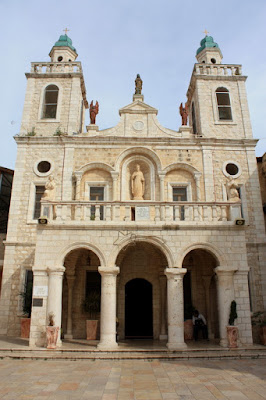 " Tres días después se celebraba una boda en Caná de Galilea y estaba allí la madre de Jesús. Fue invitado también a la boda Jesús con sus discípulos. Y, como faltara vino, porque se había acabado el vino de la boda, le dice a Jesús su madre: «No tienen vino.» Jesús le responde: « ¿Qué tengo yo contigo, mujer? Todavía no ha llegado mi hora.» Dice su madre a los sirvientes: «Haced lo que él os diga.» Había allí seis tinajas de piedra, puestas para las purificaciones de los judíos, de dos o tres medidas cada una. Les dice Jesús: «Llenad las tinajas de agua.» Y las llenaron hasta arriba. «Sacadlo ahora, les dice, y llevadlo al maestresala.» Ellos lo llevaron. Cuando el maestresala probó el agua convertida en vino, como ignoraba de dónde era (los sirvientes, los que habían sacado el agua, sí que lo sabían), llama el maestresala al novio y le dice: «Todos sirven primero el vino bueno y cuando ya están bebidos, el inferior. Pero tú has guardado el vino bueno hasta ahora.» Así, en Caná de Galilea, dio Jesús comienzo a sus señales. Y manifestó su gloria, y creyeron en él sus discípulos" (Juan 2,1-11).
Este domingo leemos en la Misa el evangelio de las bodas de Caná. El primer domingo del tiempo ordinario es el Bautismo del Señor, y en el segundo se narra otra manifestación de la divinidad del Señor: en este caso es la automanifestación que quiso hacer Jesucristo con el milagro que realiza en las bodas de Caná de Galilea.
La ciudad de Kfar Kana tiene unos 18.00 habitantes, y está situado a unos tres kilómetros de Nazaret. Es difícil distinguir cuando acaba Nazaret y empieza Caná, pues están muy cercanos. Los franciscanos, presentes hace ya tres siglos en Caná con una pequeña propiedad, consiguieron rescatar el santuario en 1879. Esto fue gracias al padre Egidio Geissler, fundador de la parroquia católica local de rito latino. En 1880 se construyó una pequeña iglesia y posteriormente se fue agrandando, con las obras que se realizaron entre 1897 y 1905. En 1885 se había construído, a unos 100 metros de distancia de la iglesia que conmemora las bodas de Caná, una capilla en honor de San Bartolomé, llamado Natanael, uno de los doce discípulos, pues él era oriundo de esta localidad.

Excavaciones arqueológicas dirigidas por el padre S. Loffreda en 1969 y por el padre E. Alliata en 1997 han sacado a la luz la sinagoga, construida sobre los restos de habitaciones precedentes. Se calcula que se construyó entre los siglos I y IV, después de Cristo. Tenía un vestíbulo porticado y en el centro una gran cisterna. De esta se conserva hasta nuestros días el subsuelo de la iglesia actual. En el ábside septentrional de la iglesia se ha encontrado un ábside aún más antiguo que contiene un sepulcro que ha sido datado entre el siglo V y el VI. Tal sepulcro, además de algún otro indicio, muestra claramente que hubo presencia cristiana sobre el lugar durante la época bizantina.
Numerosos testimonios nos hablan de un santuario edificado por los cristianos en Caná en memoria del primer milagro realizado por Jesús. Transcribimos unas letras de un peregrino anónimo del s. VI en las que habla de este lugar Santo: “(Habiendo salido de Séforis) después de tres millas llegamos a Caná, adonde el Señor fue a la boda, y nos sentamos sobre el mismo asiento, donde escribí el nombre de mis padres… todavía quedan dos hidrias; yo llené una de vino y, llevándola llena sobre la espalda, la ofrecí en el altar. En la misma fuente nos lavamos por devoción. Después fuimos a la ciudad de Nazaret”.
 Empujada por distintas necesidades, y en tiempos diversos, la tradición ha situado el recuerdo evangélico en diferentes lugares; pero a principios del siglo XVI, los peregrinos encuentran en Kfar Kanna una habitación subterránea a la cual se accede desde el interior de un edificio con columnas que ellos creían que fuese una iglesia construida por el emperador Constantino y su madre santa Elena. También se han encontrado tinajas muy grandes. Algunas se han podido reconstruir como la de la foto. Dan idea de lo grandes que pudieron ser las que se llenaron de agua y el Señor convirtió en vino.
|
|
|
|
|
The History of Earth Measurement in France.
And the marking of the Meridian
GEO - METRY
literally Earth Measurement
The powerful picture shown above shows the essence of our priest’s whole enigmatic saga. This is a view back down what has become to become known as David Wood’s Sunrise Line and was taken from a hill called Mont St Michael; this hill is 666 metres high. In the distance are the mountains of Soularac and St Bartholémy,
If one climbs onto La Tour Magdala as I did on that first day the twin snow capped peaks of St Bartholémy and Pic de Soularac can be clearly seen. These mountains have been sacred for thousands of years as the large numbers of megaliths on their slopes and the number of previously inhabited caves nearby testifies. The official designation for this mountain is St Bartholémy however the locals call this mountain “Montagne de Tabe” Thabor Mount and in a manuscript dated 1350CE it appears as the name “Mountanha die Taba” and this is in the Occitan language. The pronunciation is identical to Tabor and these mountains are a mere 5 miles from the awesome Cathar castle of Montségur. To access these peaks one starts via the La Trou de l’Ours - the Hole of the Bear. A further interesting designation is the other mountain of the twins is Soularac. This is from Soula-rac which is the Occitan language for Rock of the Sun and seems to allude to a pre-Christian and even pre-Roman era frequented by Druidic priests. In Olhagaray (1609) both of these mountains are referred to by the single name Tabor but this particular early mention of the mountain is accompanied by the date which is the night of 23rd to the 24th August which is feast day of St Bartholomew. In Fabre (1639) we find the mention of Montem Tabor and also lacus Sancti-Bartholomaei (Sacred Lake Bartholomew) and Eclesia Bartholomeo Sacrata (Sacred Church Bartholomew) in the same manuscript so it can be assumed that the mountain was known by the name Mount Tabor up until the 17th century with both a church and a lake dedicated to Bartholomew. In the chart of Roussel (1730) speaks of the Mountains of St Berthelmy and Tabe and also of the Etang (pond) of Tabe. Again in 1737 another manuscript speaks of Thabor Mount and S Barthelemi, however the name also referred to the Montagne d’Appy but this may be confusion with a nearby mountain of that name. The mountains are Bartholomew and Soularac initials B and S and the reader is reminded of the phrase on Saunière’s bookplate ‘Trigono Centri Centrum' - The Centre in the triangle of the Centre’. One is also reminded that the initials B.S. are also found above a devil holding some water at the entrance of the church of Saint Marie Madeleine in Rennes le Chateau.
Interestingly Soularac is mentioned in a report of a meridian measurement by the well respected astronomer Delambre in 3 volumes of work from 1806 to 1810 that followed ground measurements in 1797 by Méchain[i1] here it is referred to as Eastern Peak of the Saint-Bartholémy Mount and the “Peak of Estangtost”. Delambre was born in Amiens in 1749 and was an astronomer and mathematician; he was a remarkable man who had a childhood illness which gave him the fear that he would soon go blind. As a result of this he read every book that was available to him and immersed himself in Greek and Latin literature. He also acquired the ability to memorise entire pages and to recite them verbally word for word. He also became fluent in Italian, English and German and even published a book called “Rules and methods to easily learn English.”. However his interest in astronomy is quite relevant to our story and Delambre’s contribution to the science of Astronomy is so great that he has a crater on the moon named after him.
In 1790 the French National Constituent Assembly asked the French Academy of Sciences to introduce a new unit of measurement and they decided on the metre. This is defined as 1/10,000,000 of the distance from the North Pole to the equator and Academy of Sciences prepared to measure the length of the meridian between Dunkerque (Dunkirk) and Barcelona and this portion of the meridian also passes through Paris. In April 1791 the task of placing the meridian was given to Jean-Dominique de Cassini, Adrien Legendre and Pierre Méchain. Cassini was chosen to head the northern expedition but as a royalist he refused to serve under the revolutionary government. On February 15th 1792 Delambre was elected unanimously a member of the French Academy of Sciences and in May 1792, after Cassini’s final refusal Delambre was placed in charge of the Northern expedition, which measured down the meridian from Dunkirk to Rodez. Pierre Méchain headed the southern expedition from Rodez to Barcelona. The measurements were finished by 1798 and the data gathered was presented to an international conference in 1799. Delambre was appointed director of the Paris Observatory after the death of Méchain and he was also appointed a professor of Astronomy at the college de France. Assisted by his wife and his stepson Delambre continued the measurement of baselines and also the latitude survey for the Paris Observatory. In June 1792 it appears that Méchain made a mistake in his calculations to fix the size of the metre and having discovered the mistake his guilt nearly drove him mad and he died in an attempt to correct himself. Delambre discovered the mistake but decided to seal the evidence of the error in a vault at the Paris Observatory and it was only discovered 200 years later.
A clue of the relevance of Delambre to our story besides his mention in his writings of the mountain of Soularac (Solar Rock) can be found in his full name - Jean Baptiste Joseph chevalier Delambre for he was a member of the chivalric Order of Saint Michael (Ordre de Saint-Michel) . This Order is the oldest Royal order of chivalry in France founded by Louis XI on August 1st 1469, It was began in France by Jean Fouquet. The statutes provided that the knights should meet annually on the feast of their patron the Archangel Michael which is of course the 29th September (Michaelmas)[i2] at the chapel of the monastery of Saint Michael off Normandy which has the nearest city of Rennes close by. The British have the Order of Saint Michael and Saint George founded in 1818 and the two orders are not to be confused and have no direct affiliation but do show a common reverence to the same archangel.
Delambre was an exceptional astronomer and mathematician and in 1795 he was admitted to the Bureau des Longitudes, becoming its President in 1800 a year later he was appointed secretary to the Académie des Sciences making him the most powerful figure in science in France. An International Commission for Weights and Measures was set up and Delambre reported his results to it in February 1799. By June of that year, after Méchain had also reported, a definitive platinum bar of length one metre [I A3] was made to become the basis of the metric system. Delambre published details of the whole project in Base du système métrique. The first of the three volumes, containing the history of measurement of the Earth and the project's triangulation data, was published in 1806. When Delambre presented it to Napoleon, the emperor said:
“Conquests will come and go but this work will endure”
In 1809, Napoleon requested that the Académie des Sciences award a prize for the best scientific publication of the decade, the award went to Delambre for his work on the meridian.
The second volume of the work, published in 1807, contained the data for the accurate latitude calculations of Dunkerque and Barcelona. The method of repeated triangulations for calculating the zero meridian is shown here above right and from this work, the length of the metre was fixed as an integer proportion of the earth’s radius. Careful observers will notice however that this line runs through the mountain of Bugarach and through La Cité d’Carcassonne.
However, outside of the village of Rennes les Bains, the Abbé Henry Boudet’s former domain, there stands an old Roman Baths in remarkable condition for its age due to its partial restoration after the Aude Valley floods of 1992. Outside of these baths, we have a plaque placed there in the year 2000 marking the meridian perhaps marking the new millennium. A marker that appears remarkably important to some even to this day.
|
|
|
|
|
Bartolomé el Apóstol
De Wikipedia, la enciclopedia libre
Bartolomé, también llamado Nathanael, fue uno de los Apóstoles de Jesús. Su nombre (en griego Βαρθολομαίος) procede del patronímico arameo bar-Tôlmay, "hijo de Tôlmay" o "hijo de Ptolomeo". Es mencionado en los tres evangelios sinópticos, siempre en compañía de Felipe (Mateo 10:3; Marcos 3:18; Lucas 6:14). En el Evangelio de Juan, donde no aparece con el nombre de Bartolomé, se le ha identificado con Nathanael, que también es relacionado siempre con Felipe. Louis Réau considera que su nombre procede de la unión de bar (hijo) y Ptolomeo, siendo por tanto, descendiente de la Dinastía Ptolemaica, aunque esto no tiene ninguna base en el Nuevo Testamento; en todo caso, hay que tener en cuenta que no era extraño para los galileos del siglo I tomar nombres griegos, o bien asimilarlos a ellos. Santiago de la Vorágine añade acerca de su figura que “se mantuvo ajeno al amor de las cosas en este mundo, vivió pendiente de los amores celestiales y toda su vida permaneció apoyado en la gracia y auxilio divino, no sosteniéndose en sus propios méritos sino sobre la ayuda de Dios”.
Fuentes bíblicas[editar]
Según el Evangelio de Juan, Natanael fue uno de los discípulos a los que Jesús se apareció en el Mar de Tiberiades después de su resurrección (Juan 21:2). A él lo había llamado Jesús por mediación de Felipe (Juan 1:45). Juan es el único evangelista que menciona a Natanael, y como en las listas de los evangelios sinópticos el nombre de Felipe es seguido por el de Bartolomé, la tradición asimiló a Bartolomé y a Natanael como uno solo.
Según los Hechos de los Apóstoles, Bartolomé fue uno de los Doce, según (Mateo 10:3), (Marcos 3:18), (Lucas 6:14). Fue también testigo de la ascensión de Jesús (Hechos 1:13).
Según una tradición recogida por Eusebio de Cesarea, Bartolomé marchó a predicar el evangelio a la India, donde dejó una copia del Evangelio de Mateo en arameo. La tradición armenia le atribuye también la predicación del cristianismo en el país caucásico, junto a San Judas Tadeo. Ambos son considerados santos patrones de la Iglesia Apostólica Armenia puesto que fueron los primeros en fundar el cristianismo en Armenia.
Iconografía[editar]

Imagen de San Bartolomé en la iglesia de Nuestra Señora de la Asunción ( Vellisca).
La imagen de San Bartolomé a lo largo de la Historia del Arte ha sufrido escasas modificaciones siendo común la representación del santo en el momento del martirio, siendo desollado, bien sobre un potro o atado a un árbol. También se le ha representado obrando milagros: resucitando a los hijos del rey Polimio y liberando a la hija de éste poseída por el demonio, en escasas ocasiones aparece siendo flagelado.
En el arte suele representársele con un gran cuchillo, aludiendo a su martirio, según el cual fue desollado vivo, razón por la que es el patrón de los curtidores. En relación también con su martirio aparece en ocasiones despellejado, mostrando su piel cogida en el brazo como si se tratara de una prenda de vestir.[1] En la época Barroca es común verlo representado como apóstol, con largo manto blanco, haciendo las escrituras sagradas y mostrando el cuchillo.
También se le representa sujetando con una cadena a una diablesa. El origen de este símbolo puede ser doble: 1º en los evangelios apócrifos, San Bartolomé requiere a Cristo resucitado que le muestre al maligno "Belial", después de habérselo mostrado, Jesús le indica "Písale la cerviz y pregúntale"; 2º según la tradición, expulsó a un demonio, denominado "Astaroth", de un templo donde éste vivía dentro de una estatua. San Bartolomé demostró la ineficacia de la estatua, que decía curar las enfermedades, expulsó al demonio y consagró el templo a Jesús.
Respecto a su fisonomía, el santo es representado según la descripción que Berith hace a los enfermos y que así es narrada en La leyenda dorada de Santiago de la Vorágine: “Es un hombre de estatura corriente, cabellos ensortijados y negros, tez blanca, ojos grandes, nariz recta y bien proporcionada, barba espesa y un poquito entrecana... Su semblante presenta constantemente aspecto alegre y risueño”. Natanael fue uno de los 12 discípulos de Jesús quien lo acompañó por medio de Felipe cuando fue llamado cerca a Galilea.
Su martirio y muerte se atribuyen a Astiages, rey de Armenia y hermano del rey Polimio que San Bartolomé había convertido al cristianismo. Como los sacerdotes de los templos paganos, que se estaban quedando sin seguidores, protestaran ante Astiages de la labor evangelizadora de Bartolomé, Astiages mandó llamarlo y le ordenó que adorara a sus ídolos, tal como él había hecho con su hermano. Ante la negativa de Bartolomé, el rey ordenó que fuera desollado vivo en su presencia hasta que renunciase a su Dios o muriese.
En la Capilla Sixtina de Miguel Ángel, la piel que se representa es un autorretrato del mismo autor, detalle que no se descubrió hasta bien entrado el siglo XIX.
Su festividad se conmemora el 24 de agosto en la Iglesia latina; el 11 de junio en las Iglesias orientales; el 8 de diciembre entre los cristianos armenios.
Restos mortales[editar]
Sus reliquias reposan en la iglesia de San Bartolomé en la Isla Tiberina de la ciudad de Roma.
San Bartolomé es el patrón de aquellos que trabajan las pieles, fabrican o usan cuero, guantes, abrigos, cinturones y botas. También de las modistas por llevar su piel sobre los brazos. Es sanador de las convulsiones, crisis espasmódicas y enfermedades nerviosas en general.
http://es.wikipedia.org/wiki/Bartolom%C3%A9_el_Ap%C3%B3stol
|
|
|
|
|
www.youtube.com/watch?v=gBGjsQKD2fc
10 ago. 2011 - Subido por Christian Media Center en Español
Jesús tomó consigo a Pedro, a Santiago y a su hermano Juan y se los llevó a un monte. Allí se transfiguró delante ...
www.youtube.com/watch?v=1mMPGY0Jiz8
9 sept. 2011 - Subido por EASM82
Monte Tabor (La Transfiguración): TIERRA SANTA 12. EASM82 ... Hoy 6 de agosto fiesta de la transfiguración ...
www.youtube.com/watch?v=q2P60gzjGqw
15 dic. 2014 - Subido por Ana Correas
Colegio Monte Tabor. Hecho ... Motivación Oficial Monte Tabor Y Nazaret Interescolar 2014 - Duration: 3:20 ...
www.youtube.com/watch?v=T3P4F4FObuY
19 jun. 2013 - Subido por Alfil del Rey
En este segundo video del Monte Tabor, en Israel, visitamos y explicamos un poco sobre la Iglesia de la ...
www.youtube.com/watch?v=IrD4kDKIHhE
12 jun. 2013 - Subido por Alfil del Rey
Monte Tabor, en Israel. A todos nuestros amigos que nos han solicitado la explicación del lugar de la ...
|
|
|
|
|
CRISTO, MOISES Y ELIAS (TRES)
PEDRO, SANTIAGO Y JUAN (TRES)
TREINTA Y TRES
|
|
|
|
|
The Franciscan church is attached to the Church of the Holy Sepulchre by the Magdalene chapelOne of the most holiest churches, located in Jerusalem at the traditional site of Golgotha - the place of Jesus Crucifixion and burial.Matthew 27: 33, 60: "And when they were come unto a place called Golgotha....And laid it in his own new tomb, which he had hewn out in the rock: and he rolled a great stone to the door of the sepulchre, and departed"http://www.biblewalks.com/Sites/Sepulcher.html#MagdaleneOn the floor, in front of the Holy Sepulchre, is a mosaic figure of a double headed eagle - symbol of the Byzantine empire and the Greek Orthodox church.that is also the symbol used by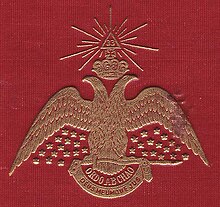 Morals and Dogma by Pike and the Scottish RitesThe first mention of a double-headed eagle in the West dates from 1250, in a roll of arms of Matthew of Paris for Emperor Frederick II of the Holy Roman Empire. Usually depicted black on a gold background, it replaced the earlier single-headed eagle, and was subsequently adopted in the coats of arms of many German cities and aristocratic families. After the dissolution of the Holy Roman Empire in 1806, the double-headed eagle was retained by the Austrian Empire, and served also as the coat of arms of the German Confederation.The double-headed eagle was part of the emblem of the Order of the Solar Temple. This cult was started by Joseph Di Mambro and Luc Jouret in 1984 in Geneva. It gained notoriety in 1994 when members of the cult committed mass suicide and murders in two villages in Switzerland, followed in 1997 by suicide/murders in Canada.http://en.wikipedia.org/wiki/Double-headed_eagleThe Greek Orthodox chapel has a circle floor with a sun and wavy rays coming from itthere is a rock there which the crack goes down to the chapel of Adam belowit is said that Jesus blood dripped down to reach the skull of AdamMagdalen's star has points and a green stone centerhttp://www.sacred-destinations.com/israel/jerusalem-holy-sepulchre-photos/slides/franciscan-mass-cc-irithThe Franciscanshe impact of the Franciscan Third Order Secular upon the feudal society of medieval Europe has been held to be considerable. Among its ways of impacting that era was the prohibition on the brothers of the Order from bearing arms. This stance of pacifism in a society with frequent feuds and wars was upheld by the authority of the Church, and limited the ability of the nobility and towns to demand that all men be subject to serving in battle.Also, the admission to the Order of members from all stations in life on an equal basis was a mechanism for promoting social change in a period of rigid social stratification.The Third Order has known many notables among its members. Outstanding among them is Saint Elisabeth of Hungary, though it is not established to all that she ever formally joined;[3] she is, however, Patroness of the Order. Additionally, she is traditionally paired with St. Louis, King of France, declared Patron of the Order.Among other notable figures were: St. Ferdinand, King of Castile; St. Elizabeth of Portugal, grand-niece of the first St. Elizabeth; St. Rosa of Viterbo; St. Margaret of Cortona; St. Thomas More; Blessed Umiliana Cerchi; Blessed Angela of Foligno; St. Ivo of Kermartin; Saint John Vianney, the famed Curé of Ars, France. Of names celebrated in history for literature, arts, politics, inventions, etc., Blessed Raymond Lull; Dante, Giotto, Petrarch, Cola di Rienzo, Christopher Columbus, Vasco da Gama, Cervantes, Lope de Vega, Galvani, Alessandro Volta, Garcia Moreno, Franz Liszt, and Lady Georgiana Fullerton. Popes Pius IX and Leo XIII were members of the Third Order, as also were Pope St. Pius X and the Blessed Pope John XXIIIThe Third Order of Saint Francis CanadaThe Third Order of St. Francis was established by the Friars Minor Recollects at Quebec in 1671, and some years later at Three Rivers and Montreal. Considering the sparse population of the country, it was in a flourishing condition. In 1681 a Recollect notes that "many pious people of Quebec belong to the Third Order".After the cession of Canada to England, the Third Order, deprived of its directors, the Recollect Franciscan friars, seemed to have disappeared gradually, only to flourish anew thirty years after the death at Montreal in 1813 of the last Recollect friar.The Third Order was re-established about 1840 by Mgr. Ignatius Bourget, Bishop of Montreal. Fervent fellow-labourers helped the holy prelate to spread the Third Order in Montreal, notably Canon J.A. Paré and the Sulpicians C. E. Gilbert and A. Giband. Mgr. Bourget established a fraternity of women, 6 May 1863, and one of men, 13 June 1866; both were directed by the Sulpicians till 1874, by Canon P. E. Dufresne from 1874 till 1881, by the Jesuits from 1881 till 1888, and by the Sulpicians from 1888 till 1890; since then by the Friars Minor. Mgr. Fabre, successor to Bishop Bourget, in a letter (3 September 1882) to the priests and faithful of his diocese, says: "We have in our midst the tertiaries of St. Francis, who are known to you all by the edification they give, and by the good odour of all the virtues which they practise in the world." The Third Order was reintroduced at Quebec almost at the same time as at Montreal. On 19 November 1859, Father Flavian Durocher, O.M.I., received the profession of two women, after a year's novitiate. These were joined by others, until in 1876 Quebec City alone possessed over 200 tertiaries, while in the Province of Quebec several parishes had groups of tertiaries.Saint Francis of Assisi rejected the urban materialism of his parents and local church. He established a mendicant, or beggar, lifestyle for the followers of his church-approved order—Franciscan friars for men and the Poor Clares for women. Many religious thinkers in the 1200s were influenced by the earlier philosophy of Christian Neoplatonism, a synthesis of Plato’s ideals and Christian mysticism. Under that influence, they rejected the Aristotelian focus on rationalizing religion and believed God's divine revelation could best be understood through experience. The Cistercian Bernard of Clairvaux, who died in 1153, feared that Abelard's scholastic logic would deaden true spiritual understanding. Later, Bonaventure, a Franciscan who lived from 1221 to 1274, developed a mystical philosophy guiding Christians toward contemplation of the ideal realm of God.http://history-world.org/dynamic_culture_of_medieval_euro.htmAlexander of Hales, Bonaventure, and John Duns Scotus, the "Doctor of Wonders" Roger Bacon, and the well-known mystic authors and popular preachers David of Augsburg and Berthold of Regensburg.as well as Anthony of Padua Morals and Dogma by Pike and the Scottish RitesThe first mention of a double-headed eagle in the West dates from 1250, in a roll of arms of Matthew of Paris for Emperor Frederick II of the Holy Roman Empire. Usually depicted black on a gold background, it replaced the earlier single-headed eagle, and was subsequently adopted in the coats of arms of many German cities and aristocratic families. After the dissolution of the Holy Roman Empire in 1806, the double-headed eagle was retained by the Austrian Empire, and served also as the coat of arms of the German Confederation.The double-headed eagle was part of the emblem of the Order of the Solar Temple. This cult was started by Joseph Di Mambro and Luc Jouret in 1984 in Geneva. It gained notoriety in 1994 when members of the cult committed mass suicide and murders in two villages in Switzerland, followed in 1997 by suicide/murders in Canada.http://en.wikipedia.org/wiki/Double-headed_eagleThe Greek Orthodox chapel has a circle floor with a sun and wavy rays coming from itthere is a rock there which the crack goes down to the chapel of Adam belowit is said that Jesus blood dripped down to reach the skull of AdamMagdalen's star has points and a green stone centerhttp://www.sacred-destinations.com/israel/jerusalem-holy-sepulchre-photos/slides/franciscan-mass-cc-irithThe Franciscanshe impact of the Franciscan Third Order Secular upon the feudal society of medieval Europe has been held to be considerable. Among its ways of impacting that era was the prohibition on the brothers of the Order from bearing arms. This stance of pacifism in a society with frequent feuds and wars was upheld by the authority of the Church, and limited the ability of the nobility and towns to demand that all men be subject to serving in battle.Also, the admission to the Order of members from all stations in life on an equal basis was a mechanism for promoting social change in a period of rigid social stratification.The Third Order has known many notables among its members. Outstanding among them is Saint Elisabeth of Hungary, though it is not established to all that she ever formally joined;[3] she is, however, Patroness of the Order. Additionally, she is traditionally paired with St. Louis, King of France, declared Patron of the Order.Among other notable figures were: St. Ferdinand, King of Castile; St. Elizabeth of Portugal, grand-niece of the first St. Elizabeth; St. Rosa of Viterbo; St. Margaret of Cortona; St. Thomas More; Blessed Umiliana Cerchi; Blessed Angela of Foligno; St. Ivo of Kermartin; Saint John Vianney, the famed Curé of Ars, France. Of names celebrated in history for literature, arts, politics, inventions, etc., Blessed Raymond Lull; Dante, Giotto, Petrarch, Cola di Rienzo, Christopher Columbus, Vasco da Gama, Cervantes, Lope de Vega, Galvani, Alessandro Volta, Garcia Moreno, Franz Liszt, and Lady Georgiana Fullerton. Popes Pius IX and Leo XIII were members of the Third Order, as also were Pope St. Pius X and the Blessed Pope John XXIIIThe Third Order of Saint Francis CanadaThe Third Order of St. Francis was established by the Friars Minor Recollects at Quebec in 1671, and some years later at Three Rivers and Montreal. Considering the sparse population of the country, it was in a flourishing condition. In 1681 a Recollect notes that "many pious people of Quebec belong to the Third Order".After the cession of Canada to England, the Third Order, deprived of its directors, the Recollect Franciscan friars, seemed to have disappeared gradually, only to flourish anew thirty years after the death at Montreal in 1813 of the last Recollect friar.The Third Order was re-established about 1840 by Mgr. Ignatius Bourget, Bishop of Montreal. Fervent fellow-labourers helped the holy prelate to spread the Third Order in Montreal, notably Canon J.A. Paré and the Sulpicians C. E. Gilbert and A. Giband. Mgr. Bourget established a fraternity of women, 6 May 1863, and one of men, 13 June 1866; both were directed by the Sulpicians till 1874, by Canon P. E. Dufresne from 1874 till 1881, by the Jesuits from 1881 till 1888, and by the Sulpicians from 1888 till 1890; since then by the Friars Minor. Mgr. Fabre, successor to Bishop Bourget, in a letter (3 September 1882) to the priests and faithful of his diocese, says: "We have in our midst the tertiaries of St. Francis, who are known to you all by the edification they give, and by the good odour of all the virtues which they practise in the world." The Third Order was reintroduced at Quebec almost at the same time as at Montreal. On 19 November 1859, Father Flavian Durocher, O.M.I., received the profession of two women, after a year's novitiate. These were joined by others, until in 1876 Quebec City alone possessed over 200 tertiaries, while in the Province of Quebec several parishes had groups of tertiaries.Saint Francis of Assisi rejected the urban materialism of his parents and local church. He established a mendicant, or beggar, lifestyle for the followers of his church-approved order—Franciscan friars for men and the Poor Clares for women. Many religious thinkers in the 1200s were influenced by the earlier philosophy of Christian Neoplatonism, a synthesis of Plato’s ideals and Christian mysticism. Under that influence, they rejected the Aristotelian focus on rationalizing religion and believed God's divine revelation could best be understood through experience. The Cistercian Bernard of Clairvaux, who died in 1153, feared that Abelard's scholastic logic would deaden true spiritual understanding. Later, Bonaventure, a Franciscan who lived from 1221 to 1274, developed a mystical philosophy guiding Christians toward contemplation of the ideal realm of God.http://history-world.org/dynamic_culture_of_medieval_euro.htmAlexander of Hales, Bonaventure, and John Duns Scotus, the "Doctor of Wonders" Roger Bacon, and the well-known mystic authors and popular preachers David of Augsburg and Berthold of Regensburg.as well as Anthony of Padua
_________________
Everything is Connected and there are no
coincidences
|
|
|
|
|
Spielburg thought of Bugarach first for his movie Encounters of Third Kind  then he did Raiders of the Lost Ark which was about the Ark of the Covenant  I think the Ramtha group is also interested in Bugarach
_________________
Everything is Connected and there are no
coincidences
IN-DIANA JONES/JONAS/JUAN
ARQUE-OLOGO / ARCO
JUAN MARCOS |
|
|
|
|
Abbe Boudet talked about the Language of the Birds or the Language of the Angelsthe first languageand as we have seen some languages use symbols such as Runes or Heiroglyphsmaybe the Crop circles have a languageand could this be a very prehistoric oneRennes Chateaus's water font has the angels over the demon and the Holy Water crushes down on the demonhttp://www.benhammott.com/1983%20Rennes-le-Chateau%20photographs/holy-water-demon-full-sm.jpgit is about positive and negative ...the angels positive and the demon negativein between the circular shell that holds the waterit seems underground aquifers which have minerals help conduct electric currentCrop circles tend to form over the English aquifers what you will see is a standing waveThe orginal torus/torsion field consisted of two poles. A negative pole and a positive pole. The positive pole emits energy out of it, while the negative pole consumes energy into it. Each pole forms a spiral of moving energy around it but moving in opposite directions. In the very center of each spiral is a calm place where no spin at all exists, but near infinite 'vertical' movement is present. This is the null zone or calm in the eye of the storm. When seen on end, the two spirals overlap and form the pattern above, which is sometimes called a double standing wave lotus.great article on crop circle language http://www.freewebs.com/cropcirclelanguage/this is resonanceof clockwise movementand anticlockwise movementhttp://youtu.be/sY6z2hLgYuYWe have the sun rotation in the galaxy and also a black hole in the galaxy we have matter and antimatter bi-polar field/Torsion field. Celtic Spiral at New Grange what you will see is a standing waveThe orginal torus/torsion field consisted of two poles. A negative pole and a positive pole. The positive pole emits energy out of it, while the negative pole consumes energy into it. Each pole forms a spiral of moving energy around it but moving in opposite directions. In the very center of each spiral is a calm place where no spin at all exists, but near infinite 'vertical' movement is present. This is the null zone or calm in the eye of the storm. When seen on end, the two spirals overlap and form the pattern above, which is sometimes called a double standing wave lotus.great article on crop circle language http://www.freewebs.com/cropcirclelanguage/this is resonanceof clockwise movementand anticlockwise movementhttp://youtu.be/sY6z2hLgYuYWe have the sun rotation in the galaxy and also a black hole in the galaxy we have matter and antimatter bi-polar field/Torsion field. Celtic Spiral at New Grange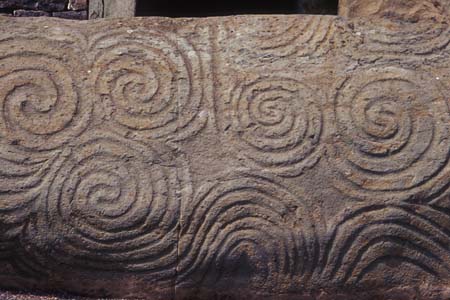
_________________
Everything is Connected and there are no
coincidences
|
|
|
|
 Primer Primer
 Anterior
181 a 195 de 705
Siguiente Anterior
181 a 195 de 705
Siguiente Último
Último
|
 Empujada por distintas necesidades, y en tiempos diversos, la tradición ha situado el recuerdo evangélico en diferentes lugares; pero a principios del siglo XVI, los peregrinos encuentran en Kfar Kanna una habitación subterránea a la cual se accede desde el interior de un edificio con columnas que ellos creían que fuese una iglesia construida por el emperador Constantino y su madre santa Elena. También se han encontrado tinajas muy grandes. Algunas se han podido reconstruir como la de la foto. Dan idea de lo grandes que pudieron ser las que se llenaron de agua y el Señor convirtió en vino.
Empujada por distintas necesidades, y en tiempos diversos, la tradición ha situado el recuerdo evangélico en diferentes lugares; pero a principios del siglo XVI, los peregrinos encuentran en Kfar Kanna una habitación subterránea a la cual se accede desde el interior de un edificio con columnas que ellos creían que fuese una iglesia construida por el emperador Constantino y su madre santa Elena. También se han encontrado tinajas muy grandes. Algunas se han podido reconstruir como la de la foto. Dan idea de lo grandes que pudieron ser las que se llenaron de agua y el Señor convirtió en vino.
